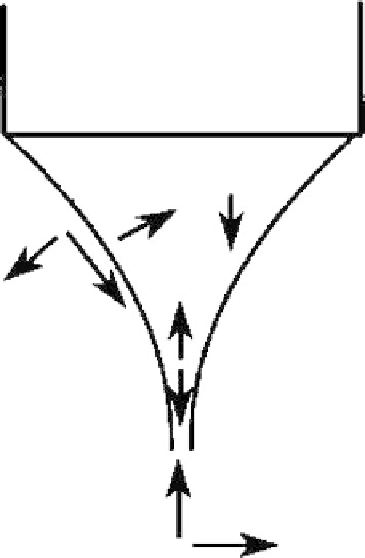Biomedical Engineering Reference
In-Depth Information
Surface
tension
Gravity
Normal
electric stress
Tangential
electric stress
Viscosity
Electric polarization stress
Z
r
FIGURE 11.5
An illustration of the forces occurring during electrospraying in a cone-jet mode. (Reprinted
from Hartman, R.P.A. et al.,
J. Aerosol Sci.
, 30, 823, 1999. © Elsevier Science. With permission.)
particles. The main parameters include solution viscosity, electrical conductivity, surface tension,
dielectric constant, applied electric potential, fl ow rate, and solution concentration. If conductivity
and viscosity of the solution are high enough, the axial momentum is very effi ciently transmitted
across the jet section through a viscous diffusion. The axial velocity profi le of the liquid becomes
almost fl at so that the surface stress acts upon the entire cross-section as a volumetric force [27,29].
If the conductivity and viscosity of the solution are low, the liquid mass needs a long axial length to
be accelerated so that the tangential stress acts on the liquid through a surface boundary layer along
most of the length of the jet.
The following equations were originally proposed to estimate the droplet diameter and the cur-
rent emitted through the liquid cone. These equations are called the scaling laws for electrospraying
in a cone-jet mode and are only valid for liquid with a fl at radial profi le of the axial liquid velocity
in the jet [29]:
(
γQK
(
Q
ε
0
ε
r
1/2
1
)
)
______
_____
d
d
=
b
1
(
ε
r
)
K
3
+
C
1
I
=
b
2
(
ε
r
)
ε
t
+
C
2
(11.4)
where
d
d
is the droplet diameter,
Q
the liquid fl ow rate,
K
the electrical conductivity,
γ
the surface
tension,
ε
r
the relative permittivity of the liquid,
ε
0
the permittivity of a vacuum,
I
the current,
b
1
and
b
2
the functions of the liquid permittivity, and
C
1
and
C
2
are the constants.
However, a revised scaling law of current and droplet size has been proposed by giving new rela-
tions for
b
1
and
b
2
and introducing constants
C
1
and
C
2
. These equations are shown as follows [23]:
(
ρε
0
1/6
)
____
d
d
=
3.78 ·
π
−
2/3
·
0.6 ·
Q
1/2
γK
(11.5)
(
QKγ
)
1/2
[
]
___________
I
=
4.25
ln ((
Q /Q
0
)
1/2
)
(11.6)


